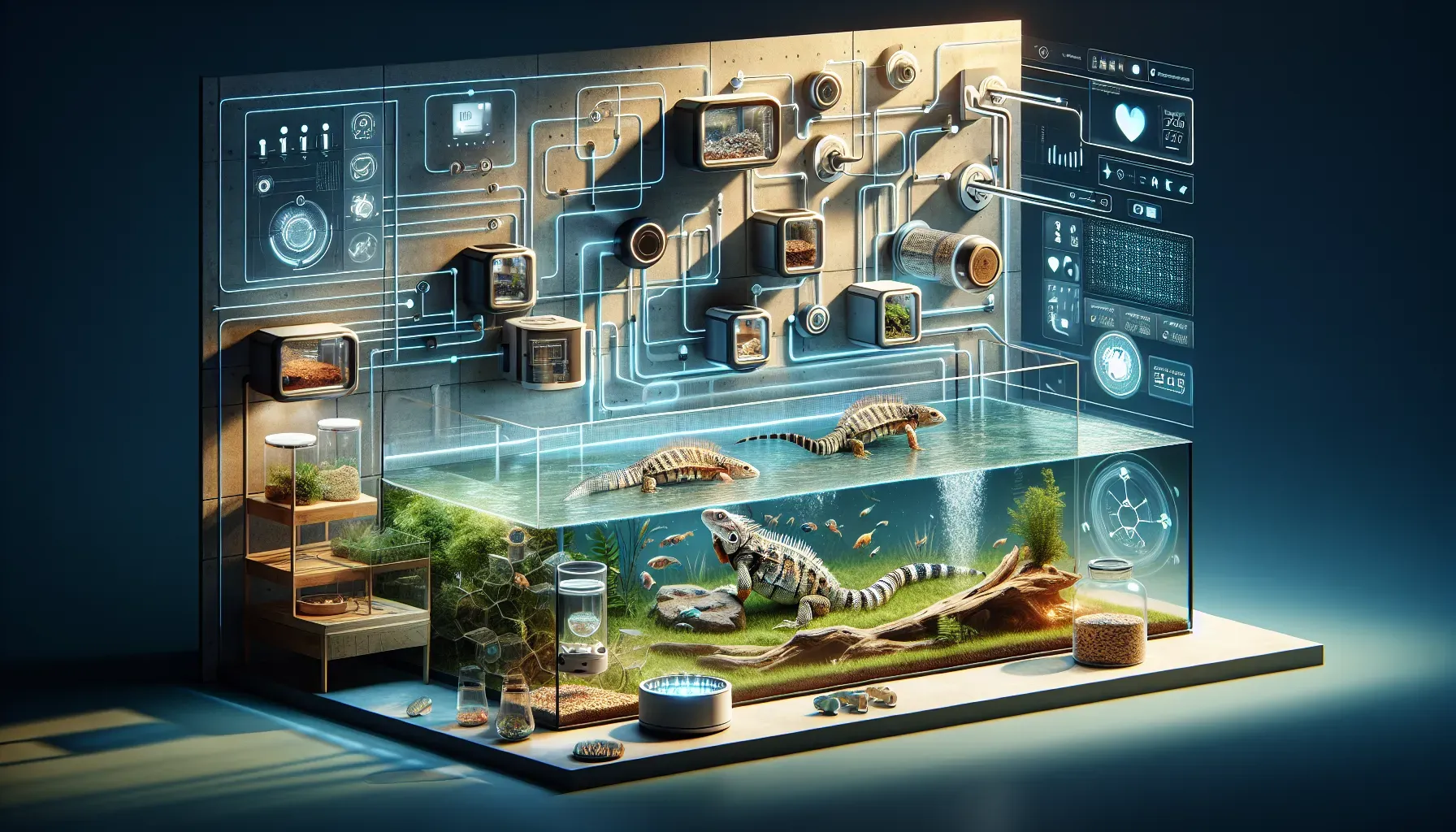From Terrariums to Tech Habitats: Revolutionizing Reptile Care with Modern Advancements

When it comes to providing the ideal temperature for reptiles, the debate between traditional heating solutions and precise environmental controls has sparked significant interest. Traditional methods, such as heat lamps and heat mats, have long been the go-to choice for maintaining ambient temperatures within reptile habitats. While these methods may suffice for some species, they often fall short in ensuring uniform heating throughout the enclosure.
Traditional Heating Solutions vs. Modern Environmental Controls
On the other hand, precise environmental controls, such as thermostats and radiant heat panels, offer a more sophisticated approach to regulating temperature. These systems not only provide accurate heat distribution but also allow pet owners to create specific temperature gradients within the habitat, mimicking the natural thermoregulation patterns observed in the wild.
With advancements in technology, reptile enthusiasts can now opt for smart heating solutions that integrate seamlessly with IoT (Internet of Things) platforms. These systems enable remote monitoring and control, ensuring that our reptilian companions enjoy consistent warmth even when we're away from home.
Understanding the crucial role of UV lighting in supporting reptile wellness has led to significant developments in lighting technologies. Traditional fluorescent and incandescent bulbs have been staples in reptile enclosures for providing basic illumination. However, these sources often fall short in delivering sufficient UVB radiation, which is essential for reptiles' calcium metabolism and overall health.
The Importance of UV Lighting for Reptile Health
The introduction of specialized UVB-emitting bulbs and fixtures has transformed the way we address reptiles' lighting needs. These advancements not only cater to UVB requirements but also offer improved energy efficiency and longevity. Moreover, integrated timers and dimmers have further personalized the lighting experience for reptiles, simulating natural day-night cycles and creating dynamic lighting gradients within their habitats.
As we delve deeper into innovative lighting solutions, LED technologies have emerged as game-changers in reptile care. LED fixtures not only provide customizable light spectrums but also contribute to energy savings and reduced heat emissions within enclosures. Additionally, smart lighting systems have paved the way for automated light cycles, offering a hands-free approach to managing reptiles' photoperiod requirements.
The integration of IoT in reptile care has redefined our ability to monitor our pets' health and activity levels in real time. Traditionally, observing behavioral cues and physical traits served as primary indicators of a reptile's well-being. However, IoT-enabled sensors and cameras now offer unparalleled insights into their daily activities, allowing us to detect subtle changes that may reveal underlying health concerns.
IoT-powered health monitoring systems can track parameters such as temperature gradients, humidity levels, and even movement patterns within the enclosure. By leveraging this technology, pet owners can receive instant alerts and notifications regarding any deviations from optimal conditions or irregular behavioral patterns, enabling prompt intervention when necessary.
Real-Time Health Monitoring with IoT Technology
Moreover, the data collected through IoT devices can be analyzed to identify long-term trends, providing valuable information for veterinarians during routine check-ups or when addressing specific health issues. This proactive approach to reptile care exemplifies how technology has elevated our ability to ensure the holistic well-being of these fascinating creatures.
Automation has become increasingly prevalent in modern reptile husbandry, offering unparalleled convenience and precision in habitat management. Automated systems encompass a wide range of functionalities, including temperature regulation, lighting control, humidity maintenance, and even feeding schedules.
One noteworthy advancement is the development of smart terrariums equipped with integrated environmental control modules. These all-in-one solutions enable pet owners to establish and maintain customized climatic conditions with minimal manual intervention. By harnessing the power of automation, these habitats emulate natural environments more accurately while streamlining routine care tasks.
Creating Optimal Habitats with Automated Systems
Furthermore, automated feeding systems have alleviated concerns associated with dietary consistency and portion control. These systems can dispense measured quantities of live insects or pre-packaged diets at programmed intervals, ensuring that reptiles receive their nutritional requirements reliably even during owners' absence.
The seamless integration of automated systems not only optimizes habitat conditions but also empowers pet owners to monitor and adjust settings remotely via smartphone applications or web interfaces. This level of control not only enhances the well-being of our reptilian companions but also fosters peace of mind for caretakers.
For keepers of aquatic reptiles, maintaining pristine water quality is paramount for their pets' health and vitality. Traditional filtration systems involving basic water pumps and mechanical filters have been relied upon for maintaining water clarity and minimizing waste accumulation within aquatic enclosures.
However, recent advancements have brought forth highly efficient filtration technologies tailored specifically for aquatic reptiles' unique requirements. These advanced filtration systems integrate biological, mechanical, and chemical filtration processes to effectively remove impurities and support a balanced aquatic ecosystem within the enclosure.
Innovative features such as adjustable flow rates, surface skimming capabilities, and customizable media arrangements have set a new standard in aquatic reptile husbandry. These advancements not only contribute to maintaining optimal water parameters but also reduce maintenance frequency by promoting long-term stability within the aquatic environment.
Related Article: The Everlasting Innovation of Pet Microchipping: Tracing Its Historical Impact and Future Implications
Advanced Filtration Systems for Aquatic Reptiles
By incorporating automated water quality monitoring sensors that interface with filtration systems, pet owners can receive real-time updates on key parameters such as pH levels and ammonia concentrations. This proactive approach empowers caretakers to address potential water quality issues promptly before they impact their amphibious companions' well-being.
The concept of biophilic design has gained traction in modern reptile habitat construction, emphasizing the integration of natural elements within enclosures to promote psychological well-being and environmental enrichment for captive reptiles. Biophilic design principles revolve around creating habitats that mimic natural ecosystems while ensuring functionality and aesthetic appeal.
Incorporating living plants within terrariums not only enhances visual aesthetics but also contributes to air purification while creating microhabitats that simulate wild environments for reptiles. Additionally, naturalistic substrate materials derived from coconut husks or bioactive soil blends foster beneficial microbial activity while providing natural burrowing opportunities for certain species.
Rock formations, driftwood structures, and strategically positioned hideaways further enrich the environmental diversity within enclosures while affording reptiles opportunities for exploration and thermoregulation behaviors akin to their natural habitats.
Biophilic Design in Reptile Enclosures: A Natural Approach
This approach aligns with Tails' Talks ethos of enhancing wellness through environmentally-conscious practices while fostering a deeper connection between pet owners and their scaly companions by creating sustainable habitats that mirror natural landscapes.
The traditional practice of offering live prey items as a primary food source for pet reptiles has evolved alongside technological advancements that provide alternative feeding methods tailored to meet diverse dietary needs more efficiently.
Live prey items like crickets or mealworms have long been utilized due to their nutritional value and behavioral enrichment benefits; however, innovations in nutritional science have given rise to commercially available insect gut-loaded capsules fortified with essential vitamins and minerals that serve as convenient alternatives to live insects. Subsequently, the supplementation of balanced commercial diets formulated specifically for different species has gained popularity due to the enhanced convenience, shelf-stability, and nutritional consistency they offer.
Furthermore, dietary supplementation products now come in various formats,such as dusting powders,sprays, and liquid additives,enabling pet owners to fortify feedings effectively. These advancements underscore a shift towards balanced nutrition delivery methods that align with Tails' Talks commitment to promoting holistic wellness for pet companions through innovative yet practical solutions.
These toys incorporate intelligent features,such as motion sensors,luminous displays,and interactive sounds that cater to different sensory stimuli, recreating hunting instincts and exploratory behaviors observed in the wild. Additionally, the incorporation of treat-dispensing mechanisms fosters engagement while encouraging physical activity.
With an emphasis on promoting naturalistic behaviors, these tech toys align with Tails' Talks values, enriching the lives of pet reptiles by fostering cognitive engagement and physical dexterity, all within a safe and controlled environment.
Tails' Talks celebrates the remarkable advancements in modern Reptile Care, embracing technology-driven solutions that elevate husbandry practices while prioritizing the well-being of our scaly companions. Through a harmonious blend of tradition and innovation, we continue to discover new means of nurturing and understanding these incredible creatures, ensuring their welfare and happiness remain at the forefront of every decision.
Frequently Asked Questions
Traditional heating solutions for reptiles include heat lamps and heat mats, which have been commonly used to maintain ambient temperatures in enclosures. While these methods can be effective for some species, they often lack uniform heat distribution, making them less ideal for certain reptiles that require specific temperature gradients.
Precise environmental controls, such as thermostats and radiant heat panels, enhance reptile care by providing accurate temperature regulation and allowing for specific temperature gradients. This mimics natural thermoregulation patterns, ensuring that reptiles can maintain optimal body temperatures, which is crucial for their health and well-being.
Recent advancements in UV lighting include specialized UVB-emitting bulbs that provide essential radiation for calcium metabolism in reptiles. These new lighting technologies offer improved energy efficiency and longevity, along with features like integrated timers and dimmers to simulate natural day-night cycles effectively.
IoT technology benefits reptile health monitoring by enabling real-time tracking of health parameters such as temperature, humidity, and movement patterns. With IoT-enabled sensors and cameras, pet owners receive instant alerts about any irregularities, allowing for timely interventions and better overall care of their reptiles.
Automated systems for reptile habitats offer features like temperature regulation, lighting control, humidity maintenance, and programmed feeding schedules. These smart terrariums allow pet owners to create customized environments with minimal manual intervention, enhancing the accuracy of habitat conditions while simplifying routine care tasks.
Advanced filtration systems improve aquatic reptile care by integrating biological, mechanical, and chemical filtration processes to maintain water quality. These systems effectively remove impurities while promoting a balanced ecosystem, featuring adjustable flow rates and automated monitoring sensors that alert owners to changes in water parameters.
Biophilic design in reptile enclosures focuses on incorporating natural elements to enhance the psychological well-being of captive reptiles. This approach includes using living plants, natural substrates, and varied structures that mimic wild habitats, promoting environmental enrichment while fostering a deeper connection between pets and their owners.
Nutritional delivery for pet reptiles has evolved from relying solely on live prey to incorporating alternative feeding methods. Innovations now include gut-loaded insect capsules fortified with vitamins and minerals, as well as balanced commercial diets that offer convenience and nutritional consistency without the need for live insects.
Interactive tech toys play a significant role in enriching the lives of reptiles by providing mental stimulation through features like motion sensors and treat-dispensing mechanisms. These toys encourage natural hunting instincts and exploratory behaviors while promoting physical activity within a safe environment tailored to their needs.
Monitoring water quality is crucial for aquatic reptiles because it directly impacts their health and vitality. Maintaining optimal parameters such as pH levels and ammonia concentrations helps prevent disease and ensures a stable environment. Advanced filtration systems with automated monitoring provide real-time updates to facilitate proactive care.






